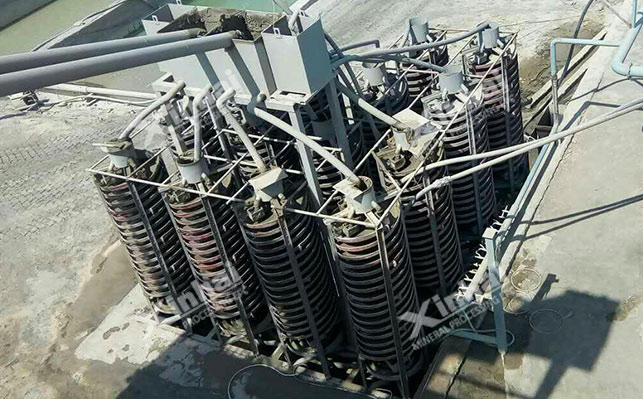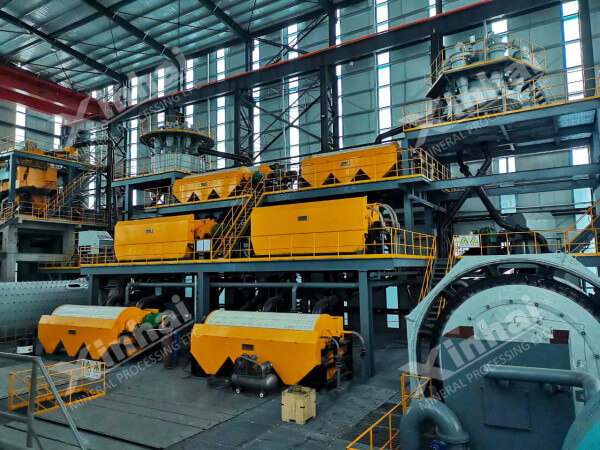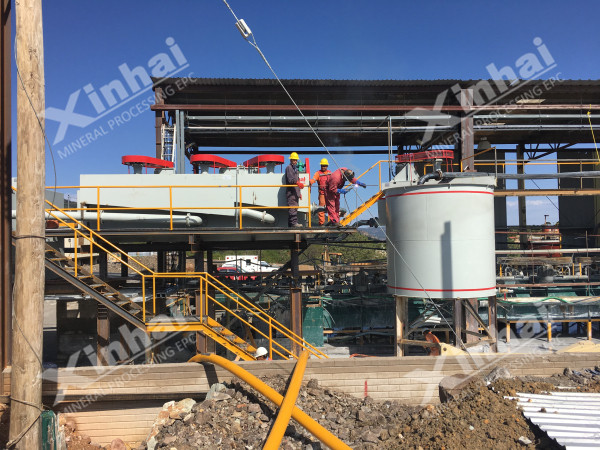There are mainly the following types of chromite: chromite, tremolite chromite and hydroxy chromite. Different chromite ores have different compositions, and the determination of beneficiation methods and process flows needs to be determined based on the main components. This article introduces the commonly used beneficiation methods, applicable types, and chromite beneficiation process flows for chromite beneficiation.
1.1. Chrome ore gravity separation method
Gravity separation is suitable for processing chromium ores with coarse particle size and large density difference. Gravity separation is widely used in chromite beneficiation because there is a large density difference between chromite and associated minerals.
Commonly used gravity separation equipment includes jigs, shaking tables, spiral chutes, etc. Among them, jigs are suitable for processing coarse chromite, while shaking tables and spiral chutes are suitable for processing fine chromite.

Gravity separation can obtain better separation indicators when processing chromite with coarse embedded particle size, produce coarse concentrate or mixed concentrate, and also obtain final concentrate. Gravity separation has the advantages of simple equipment manufacturing, good stability, convenient operation, mature technology, etc., and does not require the use of reagents, and the discharged tailings have little environmental pollution. Therefore, gravity separation is suitable for the beneficiation of chromite with large density difference between chromite and associated minerals in chromite and coarse particle size.
1.2. Chromium ore magnetic separation
Magnetic separation is suitable for processing chromium ore containing magnetic minerals, especially magnetic minerals such as magnetite and hematite that are often contained in chromium ore.
The principle of magnetic separation is to use the magnetic difference between magnetic substances in chromium ore and other non-magnetic substances, and to separate them through a magnetic separator. It has a better effect in processing chromite with good magnetic conductivity.
Chromite has weak magnetism, so it can be separated by weak magnetic separation, strong magnetic separation and other methods. Magnetic separation can effectively remove magnetic impurities in chromium ore and improve the grade of chromium concentrate.

Choose the appropriate magnetic separation method according to the magnetic strength of iron minerals in chromium ore. Strong magnetic separation is suitable for processing chromium ore with a high content of weak magnetic minerals, while weak magnetic separation is suitable for processing chromium ore with a high content of strong magnetic minerals.
1.3. Chrome ore flotation method
Flotation is a mineral separation method that uses the differences in physical and chemical properties of chromium and other gangue minerals to separate them. The core of flotation is to use flotation reagents (including collectors, frothers, regulators, etc.) to change the hydrophilicity and hydrophobicity of the mineral surface, so that some minerals can attach to bubbles and separate from gangue and other minerals.

In chromium ore beneficiation, flotation is mainly suitable for fine-grained chromium ores with complex mineral composition, as well as those chromium ores that are difficult to effectively process by gravity separation and magnetic separation. By reasonably selecting flotation reagents and process parameters, flotation can effectively improve the grade and recovery rate of chromium ore.
2.1. Crushing
Break large pieces of chromium ore into small pieces through jaw crushers and cone crushers for subsequent processing.
2.2. Grinding
The crushed chromium ore is sent to the ball mill at a uniform speed through auxiliary equipment for deep grinding, and the small pieces of chromium ore are ground into powder to improve the subsequent mineral processing efficiency. The ball mill is one of the more important equipment in mineral processing equipment, and its application range is wide, including metal mines, non-metallic mines and other fields. During the grinding process, always pay attention to the working state of the ball mill to ensure that the quality of the milled material meets the requirements. Generally speaking, the ball mill can grind chromium ore to a particle size of tens of microns or even finer.
2.3. Screening
The chromium ore particles are separated by size through equipment such as vibrating screens and drum screens. The classification method can be carried out according to the characteristics of particle size, shape, density, etc. The purpose of screening is to improve the efficiency of chromium ore dressing and reduce the cost of mineral processing.
2.4. Magnetic separation and purification
The magnetic difference between the magnetic substances in the chromium ore and other non-magnetic substances is used to separate them through a magnetic separator. It has a better effect when treating chromite with good magnetic conductivity. Magnetic separation equipment includes dry magnetic separators and wet magnetic separators. Appropriate equipment can be selected according to specific circumstances. The workflow is usually to first crush and grind the minerals to a monomer dissociation state, and then separate them through magnetic separation equipment.
2.5. Flotation
When gravity separation and magnetic separation cannot achieve a good treatment effect, flotation is used. Flotation mainly includes anionic collector flotation and cationic collector flotation, and there are also some new collectors to choose from.
2.6. Concentration and drying
The concentrate entering the flotation is dehydrated by the concentrator to remove most of the water, and then continues to be sent to the dryer for drying to obtain a usable dry concentrate or perform secondary grinding to continue extracting minerals as needed.
The chromium ore beneficiation process includes multiple links, and each link must be reasonably selected and parameter adjusted according to the beneficiation needs to obtain high-grade chromium concentrate.